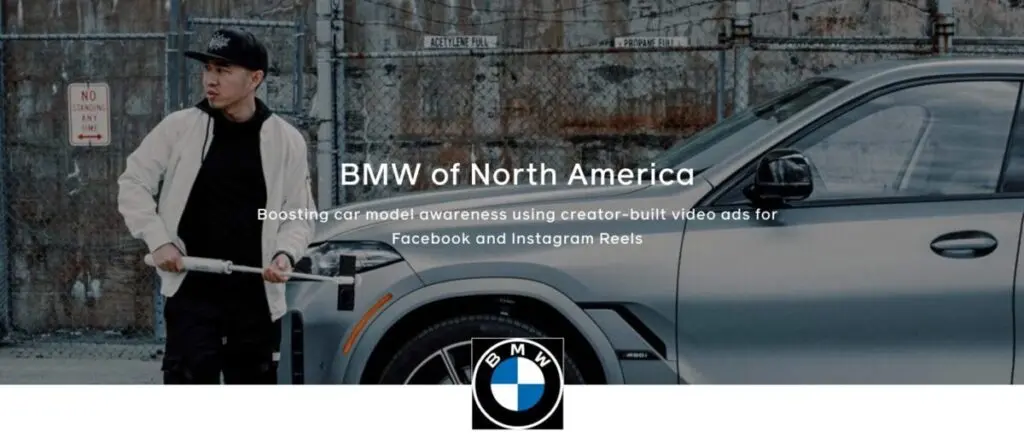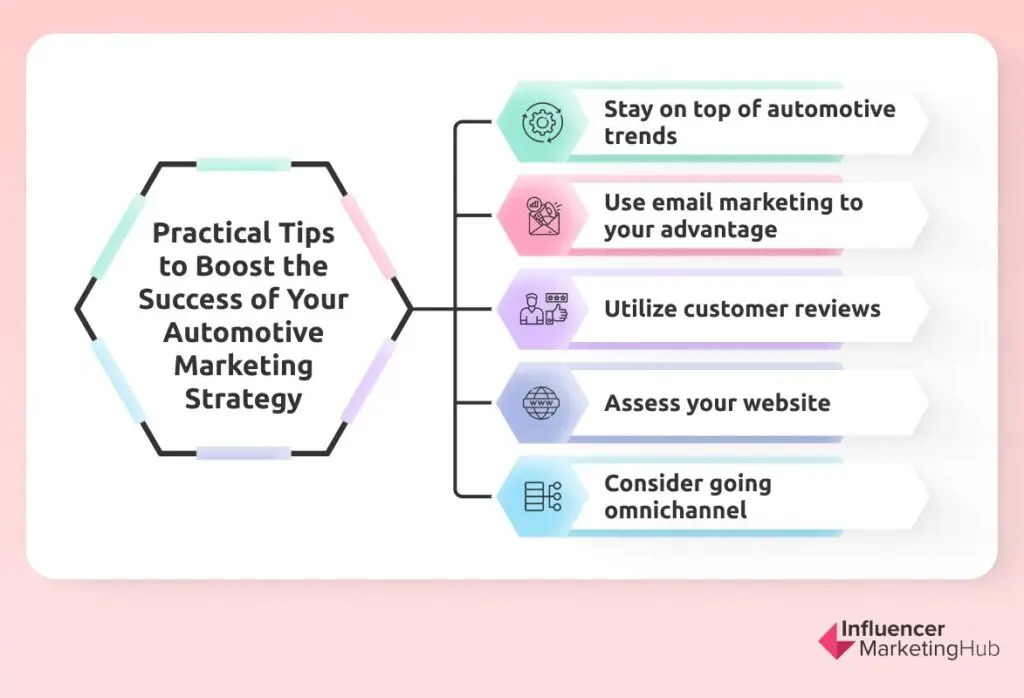For many consumers, buying a car—whether old or new—is an experience and automotive retailers and manufacturers are responding to shifts in consumer behavior by creating more seamless experiences for potential buyers. Due to changing customer expectations, businesses in the automotive field are compelled to put more focus on building relationships and experiences in the retail experience. Furthermore, today’s consumers have increased access to the information that they need, giving these companies the opportunity to shift their marketing strategies to provide their audiences with a customer-centric, value-added, and engaging approach.
2024 is predicted to be a good year for consumers to purchase new vehicles with significant discounts, pent-up demand, the easing supply chain, and a dip in interest rates being the main driving factors. It’s projected that, this year, sales for new vehicles will rise to 1% or nearly 16 million units.
Then how can you leverage effective automotive marketing to build richer experiences, attract new prospects, and stay ahead of the competition in this hot market? In this article, we’ll look at some of the automotive marketing strategies that you can use to drive and accelerate your brand’s growth.
- 1. Embrace the New
- 2. Create Relevant and Value-Add Content
- 3. Partner with Influencers
- 4. Work with an Automotive Marketing Agency
- 5. Don’t Discount Traditional Advertising
- 6. Use SEO to Your Advantage
- 7. Tap Into the Power of Social Media Marketing
- 8. Track Your Performance
- Actionable Tips to Accelerate Your Automotive Marketing Strategy’s Success
- What You Need to Know About Automotive Marketing
- Final Thoughts
- Frequently Asked Questions
How can brands make a lasting impact through effective automotive marketing? Implementing these strategies can help you build an effective marketing plan that’ll put you on top of customers’ minds.
1. Embrace the New
It’s no secret that technology is constantly evolving. For automotive brands to make a big impact on consumers, you must know how to implement these new technologies to enhance your marketing efforts. For instance, Hyundai Motor America tapped into the power of augmented reality (AR) ads to boost awareness for their vehicle launch. As a result of incorporating new technology, the brand achieved 3.3x more lift in brand familiarity, a 40% lift in favorability, and a 5.1-point lift in ad recall. By using AR, the brand was able to provide customers with an immersive experience that allowed to imagine what it’s like being inside the IQONIQ 6 and see what this new model has to offer.

Facebook Hyundai Motor America
For some brands, using extended reality (XR) technologies can be too drastic a change—but the good news is that you can incorporate new methods to up your automotive marketing. For example, consider looking into creating video content, specifically short-form videos, given that 96% of consumers watch such videos to learn more about a product or service. This is because short-form video is an engaging and highly converting way to reach your target audience. For instance, you can use videos to provide a tour of your virtual or physical showroom, showcase your vehicles, share customer testimonials or reviews, and even provide customers with access to informative content via instructional videos.
2. Create Relevant and Value-Add Content
Today’s consumers do their research online prior to engaging with a brand. They read reviews, visit your website to learn more about different car models, and check prices. By creating relevant content, you have a major opportunity to influence your audience’s decisions early on in their buyer’s journey.
Use this to your advantage to reach more people, address customer pain points, provide valuable and relevant information, and facilitate a seamless journey. Focus on creating content—it can be in the form of videos, articles, guides, or downloadable materials—that answers their questions, educates them about your brand and offerings, and solves their problems. For your content to be effective and organic, you can use SEO (or local SEO if you’re running a small business with a focus on your local area).
3. Partner with Influencers
If you’re an automotive brand, then you need to work with automotive influencers, right? Not necessarily. While influencers in the Auto & Vehicles category rack up significant total engagement and estimated reach or impressions at 122 million and 15.1 billion, respectively, they’re still outranked by Fashion & Style influencers. So, what are we driving at?

Partner with Influencers
According to a Tagger white paper, you may want to look into working with influencers from different niches or industries. That’s because while their target audiences aren’t exactly vehicle enthusiasts, this doesn’t mean that they don’t plan to purchase a vehicle in the future. While their niches or preferences might differ, they’re still a significant chunk of potential customers.
If you want to work solely with automotive influencers, then it’s best to find those who have built an audience within your target market. With that said, you may want to work with automotive influencers who utilize the following platforms (these have the highest number of posts and great engagement rates), according to Tagger:
-
Instagram – 958,000 total posts and 1.38% engagement rate
-
Facebook – 230,000 total posts and 0.06% engagement rate (while it has a lower engagement rate, Facebook is still the second most popular platform for automotive influencers)
-
YouTube – nearly 100,000 total posts, with an engagement rate of 0.51%
-
TikTok – 40,000 total posts and a 2.82% engagement rate
For example, BMW of North America used creator-built video ads to raise brand awareness. They turned to Facebook and Instagram for ad placement using Reels and other creative assets made by content creators. This resulted in a 36% increase in unique reach and an increase in the efficiency of cost per action by 20%. Note that one the creators (Phil Cohen) they worked with doesn’t exactly fall within the Auto & Vehicles niche, but they were still able to get significant results.

Facebook BMW of North America
For content types, the ones that tend to do well are:
- Videos
- Reels
- Carousels
- Photos
Note that engagement rates will vary across types depending on the platform used.
4. Work with an Automotive Marketing Agency
Automotive marketing agencies work closely with businesses in the automotive industry, from dealerships and manufacturers to parts suppliers. They have experience working with businesses in your industry, have access to the right tools, are familiar with your industry’s unique challenges and growth opportunities, and can help you build custom automotive marketing strategies using techniques like SEO, PPC advertising, and social media. Whether you’re looking to build your online presence, develop tailor-made campaigns, or create a great automotive website, then these agencies can help you take your automotive marketing strategy and campaigns to the next level.
5. Don’t Discount Traditional Advertising
We might be in the midst of the digital age but traditional advertising methods like print ads can still be effective means for automotive marketing. Consider utilizing print ads and strategic outdoor advertising techniques like billboards to increase visibility, drive awareness, and target specific audience segments.
6. Use SEO to Your Advantage
Implementing SEO doesn’t just increase your chances of getting better rankings on search engine results pages (SERPs); it can also help you attract potential customers. When done well, SEO can enhance your online visibility, but more than that, it provides you with a way to reach prospects and effectively engage them through relevant and useful content. Some ways you can implement SEO into your automotive marketing strategy include:
- Using relevant keywords in your website, ads, or content
- Including negative keywords to ensure that your ads reach your target audience and not visitors who search for related keywords
- Regularly publishing engaging, valuable, and relevant content like articles or videos
- Building your backlinks to drive website traffic and boost your authority
Furthermore, if you focus on improving your local SEO, such as by optimizing your Google Business profile and claiming your listing, you’re making it easier for local audiences to find your business and maybe even visit your physical store. Because your company information, such as your address and contact details, are more visible, prospects can also get in touch with you more easily.
7. Tap Into the Power of Social Media Marketing
Social media marketing is a powerful tool for automotive brands. With it, you can expand your reach, connect with customers, keep them engaged, educate them about your offerings, and promote your product or services. However, it’s worth noting that when it comes to social media marketing, such as social media ads, the usual approach with general ads just won’t cut it. You need to create personalized ads that are relevant to specific audience segments. Doing so allows you to convey the right message to the right people, which can help increase conversions.
Use the right platform based on the content type that you’re publishing. For example, platforms like Facebook and Instagram lend themselves well to photos and Reels, while TikTok is great for short-form videos. LinkedIn is a good channel to share articles that establish though leadership, while Twitter can be a great avenue for communicating with vehicle enthusiasts and promoting sales events.
Hyundai Motor America was able to do just that with Facebook and Instagram. The brand used these platforms to showcase in-stream video ads to build awareness for their new car model. This resulted in a lift in favorability and ad recall by 6.8 points and 8.7 points, respectively. The brand was also able to reach 44.3 million people.

Facebook Hyundai Motor America
8. Track Your Performance
Monitoring your performance lets you know whether or not your automotive marketing efforts are effective. This also gives you vital insights into how you can optimize your campaigns so that they meet your goals and objectives. To effectively track your performance, you need to determine which metrics you’ll be monitoring, such as ROI, conversion rates, and ad spend. By staying on top of your performance, you can make more informed decisions and strategic choices, identify trends, and spot areas of improvement and growth opportunities.
Actionable Tips to Accelerate Your Automotive Marketing Strategy’s Success

Tips for Automotive Marketing Strategy
Now that we’ve covered the automotive marketing strategies that can help drive growth, here are some helpful tips you can follow to ensure your brand’s long-term success in the automotive industry.
-
Automotive Marketing Strategy
Today’s consumers do their research to make informed purchasing decisions. For automotive brands to reach them, they need to look into digital marketing channels such as video marketing and online ads. You must be able to shift your campaigns to accommodate new car-buying trends. For instance, technological innovations like AI and VR are changing the way consumers approach the car-buying process. Some automotive manufacturers are also shifting their approach to marketing by implementing online shopping practices to create faster yet still personalized transactions for customers.
-
Use email marketing to your advantage.
Targeted email marketing campaigns allow you to build stronger relationships with your audience. To create effective email campaigns, consider segmenting your audience based on factors like their demographics and preferences. This way, you can create tailored messages designed to boost engagement and conversions. When going this route, some helpful tips for email marketing include leveraging email personalization and getting the timing right when sending out emails.
-
Utilize customer reviews.
Customer reviews aren’t just for social proof. They’re a crucial part of any marketing strategy, given that 50.27% of consumers read online reviews before making a purchase. Purchasing a vehicle, whether used or new, is a big decision for consumers. They’re even more likely to turn to customer reviews to learn more about your products or company before making a purchase. Utilizing reviews as part of your automotive strategy also allows you to build customer trust and encourage prospects to check out your brand. To maintain your good relationship with customers, you can ask for their feedback and if they leave a comment, whether positive or negative, make sure that you respond promptly and professionally.

Utilize customer reviews
-
Assess your website.
75% of consumers expect automotive brands to have a quality website, with 35% saying that it plays a major role in their decision to buy. Your website should be optimized and user-friendly to help visitors navigate it easily and find the information they’re looking for. Doing so also creates a better experience for potential customers and lets you leave a lasting impression on them. Furthermore, a good website makes it easy for prospects to get in touch with you if they have any inquiries or if they’re looking to discuss any offers. A well-designed website keeps users engaged, enhances your branding, and creates personalized experiences for customers. Plus, it doubles as a great hub for all your other automotive marketing campaigns. For example, your QR codes can redirect visitors to your website or dedicated landing pages. You can work with automotive web design agencies to build or refresh your website as needed.
-
Consider going omnichannel.
Digital channels are playing an even bigger role in shaping how customers approach the car-buying journey. They use online channels like search engines (53%), used car marketplaces (67%), and a manufacturer’s or retailer’s website (31%) to search for vehicles to purchase. The demand for online engagement is rising and automotive brands should be able to pivot their approach to meet this demand. By embracing the omnichannel approach, brands are more likely to provide customers with better service, boost additional sales, enhance their efficiency, and create better brand experiences.

Omnichannel
What You Need to Know About Automotive Marketing
Automotive marketing connects businesses in the automotive field with prospective buyers through promotion and advertising. By leveraging different marketing techniques and tactics, brands can attract potential customers, keep them engaged, and drive sales, with the goal of positioning themselves as the premier choice for buyers. Whether it’s through traditional advertising, social media campaigns, or creating relevant content, these companies rely on automotive marketing to create a strong presence and stay on top of the minds of potential buyers.
Challenges in Automotive Marketing
Automotive marketing does come with its fair share of challenges. For instance, as customer’s journeys increasingly move online, 48% of car buyers have already decided on what type of vehicle to purchase. In addition to that, more than 80% of consumers want to blend online and physical experiences when it comes to purchasing a vehicle.
Furthermore, some automotive businesses struggle to get the right message across, while others tend to focus on just boosting their sales instead of building their brand for long-term sustainability. Some automotive brands also struggle with embracing technology and utilizing different types of digital marketing to build their online presence and expand their reach.
Why Effective Automotive Marketing Is Crucial for Brands
Effective automotive marketing enables automotive brands to cut through the noise and craft a unique identity in this competitive market. Through better marketing, these brands can build awareness and play a major role in buyers’ decisions, all while helping them achieve a better understanding of what the brand has to offer.
Automotive marketing, when done well, helps brands create personalized and memorable experiences for prospects, connect to clients throughout their journey, attract new customers, and improve overall revenue. Lastly, effective automotive marketing is a vital component that allows brands to uncover key insights about their campaigns and use them to optimize their campaign or offer better products or services to customers.
Final Thoughts
The automotive industry is competitive, but having an effective automotive marketing strategy can help your brand grow, stand out, and be on top of customers’ minds. More than promoting your brand and what you have to offer, using these automotive strategies allows you to create richer and more memorable experiences for customers, influence their purchasing decisions, and build better, more lasting relationships with both prospects and existing customers.
Frequently Asked Questions
Why is automotive marketing important?
Effective automotive marketing helps brands reach prospects, provide them with helpful information, address their pain points, and influence purchasing decisions. It enhances their online visibility and also gives them a competitive edge.
Which digital marketing channels are most effective at reaching potential customers?
Given that today’s customers are turning to online channels to do their research before buying a car, the following are some of the most effective means to reach them:
- Search engine marketing through SEO
- Social media marketing
- Video marketing
How much does automotive marketing cost?
Costs can vary depending on factors like the scope of your project, agency size, and the services you require. For example, for SEO, monthly retainers can cost anywhere between $500 to $1,500, while hourly rates range from $75 to $100 per hour. For social media marketing, if you’re working with an agency, costs can run from $500 to upwards of $5,000 per month. If you’re planning to work with an automotive marketing agency, it’s best to discuss your budget with them so they can create custom solutions that fit your budget while still being aligned with your goals.





